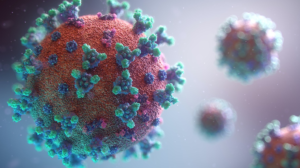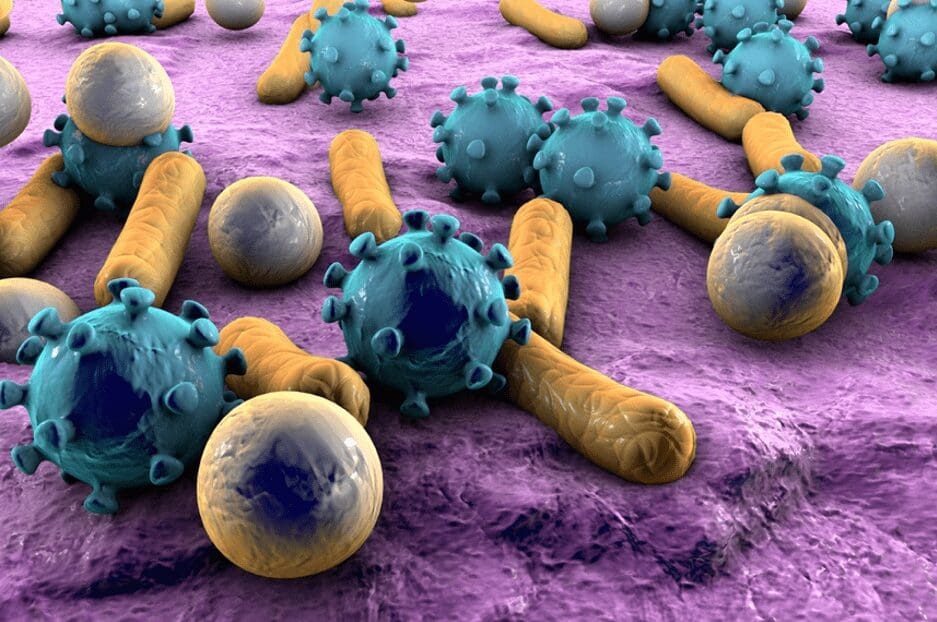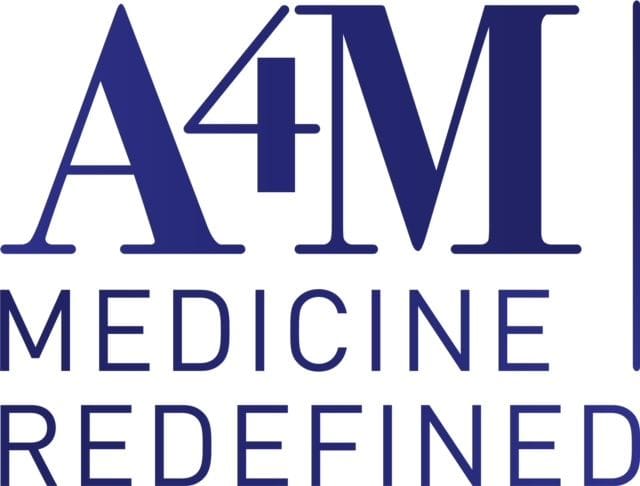Chronic Infection/Lyme Analysis/Treatment
Chronic Infection/Lyme Analysis/Treatment

Chronic infection underlies a wide variety of medically important diseases that either follow directly from primary infection or may require months, years or even decades to develop.
Chronic Viral Syndrome
 Chronic Viral Syndromes are illnesses that have developed and remain alive in the body. Chronic Viral Syndrome can weaken your immune system. This leaves you susceptible to other infections and diseases. At Dr. Magdalena Swierczewski, Integrative~Concierge Medicine, we can treat your Chronic Viral Illness so you can regain a healthy life. It’s often believed that a virus is gone after you recover from a viral infection. But many viruses “set up housekeeping” in the body and never leave.
What is a Virus?
A virus is composed of nucleic acid, either DNA or RNA, surrounded by a protein coat. It requires a living cell in which to multiply. A viral infection can lead to a spectrum of symptoms from asymptomatic (no overt symptoms) to severe disease.
Chronic Viral Syndromes are illnesses that have developed and remain alive in the body. Chronic Viral Syndrome can weaken your immune system. This leaves you susceptible to other infections and diseases. At Dr. Magdalena Swierczewski, Integrative~Concierge Medicine, we can treat your Chronic Viral Illness so you can regain a healthy life. It’s often believed that a virus is gone after you recover from a viral infection. But many viruses “set up housekeeping” in the body and never leave.
What is a Virus?
A virus is composed of nucleic acid, either DNA or RNA, surrounded by a protein coat. It requires a living cell in which to multiply. A viral infection can lead to a spectrum of symptoms from asymptomatic (no overt symptoms) to severe disease.
 What is Lyme disease?
Lyme disease is a bacterial infection you get from the bite of an infected tick. At first, Lyme disease usually causes symptoms such as a rash, fever, headache, and fatigue. But if it is not treated early, the infection can spread to your joints, heart, and nervous system. Prompt treatment can help you recover quickly.
What causes Lyme disease?
In the United States, Lyme disease is caused by bacteria called Borrelia burgdorferi (B burgdorferi). It spreads to humans through the bite of an infected tick. The ticks that spread it are blacklegged ticks (or deer ticks). They are usually found in the:
What is Lyme disease?
Lyme disease is a bacterial infection you get from the bite of an infected tick. At first, Lyme disease usually causes symptoms such as a rash, fever, headache, and fatigue. But if it is not treated early, the infection can spread to your joints, heart, and nervous system. Prompt treatment can help you recover quickly.
What causes Lyme disease?
In the United States, Lyme disease is caused by bacteria called Borrelia burgdorferi (B burgdorferi). It spreads to humans through the bite of an infected tick. The ticks that spread it are blacklegged ticks (or deer ticks). They are usually found in the:
 As part of the integrative panel, Dr Swierczewski also tests for other infectious organisms: CMV, HSV, EBV, Hepatitis A/B/C, H.pylori, Lyme (complete lyme panel) and other tick-borne disease like Rocky Mountain Spotted Fever, Anaplasmosis (anaplasma phag.), Babesia, Borrelia Burgorferi, and Bartonella.
As part of the integrative panel, Dr Swierczewski also tests for other infectious organisms: CMV, HSV, EBV, Hepatitis A/B/C, H.pylori, Lyme (complete lyme panel) and other tick-borne disease like Rocky Mountain Spotted Fever, Anaplasmosis (anaplasma phag.), Babesia, Borrelia Burgorferi, and Bartonella.
 Chronic Viral Syndromes are illnesses that have developed and remain alive in the body. Chronic Viral Syndrome can weaken your immune system. This leaves you susceptible to other infections and diseases. At Dr. Magdalena Swierczewski, Integrative~Concierge Medicine, we can treat your Chronic Viral Illness so you can regain a healthy life. It’s often believed that a virus is gone after you recover from a viral infection. But many viruses “set up housekeeping” in the body and never leave.
What is a Virus?
A virus is composed of nucleic acid, either DNA or RNA, surrounded by a protein coat. It requires a living cell in which to multiply. A viral infection can lead to a spectrum of symptoms from asymptomatic (no overt symptoms) to severe disease.
Chronic Viral Syndromes are illnesses that have developed and remain alive in the body. Chronic Viral Syndrome can weaken your immune system. This leaves you susceptible to other infections and diseases. At Dr. Magdalena Swierczewski, Integrative~Concierge Medicine, we can treat your Chronic Viral Illness so you can regain a healthy life. It’s often believed that a virus is gone after you recover from a viral infection. But many viruses “set up housekeeping” in the body and never leave.
What is a Virus?
A virus is composed of nucleic acid, either DNA or RNA, surrounded by a protein coat. It requires a living cell in which to multiply. A viral infection can lead to a spectrum of symptoms from asymptomatic (no overt symptoms) to severe disease.
- People may get viruses by swallowing or inhaling them, by being bitten by insects, through sexual contact, or congenitally (passed by a pregnant person to the fetus).
- Most commonly, viral infections involve the nose, throat, and upper airways, or systems such as the nervous, gastrointestinal, and reproductive systems.
- Doctors may base the diagnosis on symptoms, blood tests and cultures, or examination of infected tissues.
- Antiviral drugs may interfere with the reproduction of viruses or strengthen the immune response to the viral infection.
- Recurrent fevers
- Hives
- Skin rashes
- Periods of exhausting fatigue following a stressful event
- Frequent sore throat
- Intestinal distress
- Chronic sinus or lung infections
- Chronic yeast (Candida) infection
- Herpes Simplex 1 (HSV1) – the “fever blister/cold sore” virus
- Herpes Simplex 2 (HSV2) – Genital Herpes
- Varicella Virus – Chicken Pox/Shingles
- Epstein-Barr Virus (EBV) – “Mono”, or Infectious Mononucleosis
- Cytomegalovirus (CMV) – this virus is a particularly dangerous virus, and can affect many systems; brain, sinuses, retinas, esophagus, stomach, intestines, liver, and skin
 What is Lyme disease?
Lyme disease is a bacterial infection you get from the bite of an infected tick. At first, Lyme disease usually causes symptoms such as a rash, fever, headache, and fatigue. But if it is not treated early, the infection can spread to your joints, heart, and nervous system. Prompt treatment can help you recover quickly.
What causes Lyme disease?
In the United States, Lyme disease is caused by bacteria called Borrelia burgdorferi (B burgdorferi). It spreads to humans through the bite of an infected tick. The ticks that spread it are blacklegged ticks (or deer ticks). They are usually found in the:
What is Lyme disease?
Lyme disease is a bacterial infection you get from the bite of an infected tick. At first, Lyme disease usually causes symptoms such as a rash, fever, headache, and fatigue. But if it is not treated early, the infection can spread to your joints, heart, and nervous system. Prompt treatment can help you recover quickly.
What causes Lyme disease?
In the United States, Lyme disease is caused by bacteria called Borrelia burgdorferi (B burgdorferi). It spreads to humans through the bite of an infected tick. The ticks that spread it are blacklegged ticks (or deer ticks). They are usually found in the:
- Northeast
- Mid-Atlantic
- Upper Midwest
- Pacific coast, especially northern California
- Stage 1 is called early localized Lyme disease. The bacteria have not yet spread throughout the body.
- Stage 2 is called early disseminated Lyme disease. The bacteria have begun to spread throughout the body.
- Stage 3 is called late disseminated Lyme disease. The bacteria have spread to distant sites such as the joints and nerves.
- A red rash called erythema migrans (EM). Most people with Lyme disease get this rash. It gets bigger over several days and may feel warm. It is usually not painful or itchy. As it starts to get better, parts of it may fade. Sometimes this makes the rash look like a “bull’s-eye.”
- Fever
- Chills
- Headache
- Fatigue
- Muscle and joint aches
- Swollen lymph nodes
- Severe headaches and neck stiffness
- Additional EM rashes on other areas of your body
- Facial palsy, which is a weakness in your facial muscles. It can cause drooping on one or both sides of your face.
- Arthritis with severe joint pain and swelling, especially in your knees and other large joints
- Pain that comes and goes in your tendons, muscles, joints, and bones
- Heart palpitations, which are feelings that your heart is skipping a beat, fluttering, pounding, or beating too hard or too fast
- An Irregular heart beat (Lyme carditis)
- Episodes of dizziness or shortness of breath
- Inflammation of the brain and spinal cord
- Nerve pain
- Shooting pains, numbness, or tingling in the hands or feet
 As part of the integrative panel, Dr Swierczewski also tests for other infectious organisms: CMV, HSV, EBV, Hepatitis A/B/C, H.pylori, Lyme (complete lyme panel) and other tick-borne disease like Rocky Mountain Spotted Fever, Anaplasmosis (anaplasma phag.), Babesia, Borrelia Burgorferi, and Bartonella.
As part of the integrative panel, Dr Swierczewski also tests for other infectious organisms: CMV, HSV, EBV, Hepatitis A/B/C, H.pylori, Lyme (complete lyme panel) and other tick-borne disease like Rocky Mountain Spotted Fever, Anaplasmosis (anaplasma phag.), Babesia, Borrelia Burgorferi, and Bartonella. *To schedule an appointment, please call or email:
telephone: 631-283-0015
email: office@drmagdalenas.com
In office, Telehealth, Virtual visit available
Office locations in Southampton and Manhattan








